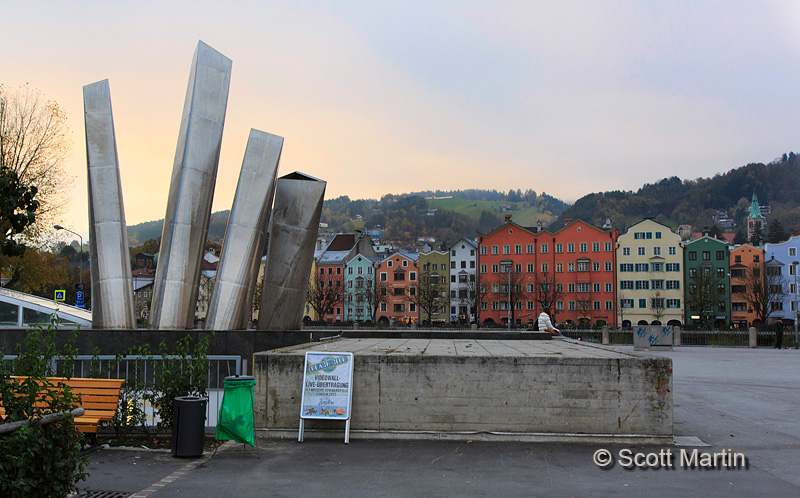
by Scott Martin Photography | Nov 23, 2013 | Blog, Cityscapes, Educational, Landscapes, Travel
After one last Vaporetto ride along the Grand Canal, we arrived back at the Venice Car Park where we loaded up our luggage and headed North for the 400 km drive to Innsbruck, Austria. The sun was descending below the mountains when we arrived at our hotel in the Old Town section of Innsbruck. We walked to the Town Square where we enjoyed some fine Austrian cuisine after which we wandered around recording some memories of this city that hosted the 1964 and 1976 Winter Olympics.
The remnants of the Olympic flame monument in the park where the Olympic medals were awarded almost fifty years ago.

The Goldenes Dachl, or Golden Roof is Innsbruck’s most famous landmark and is a three-story balcony built in the fifteenth century as a palace for Emperor Maximilian I. The balcony was their private perch for watching the festivals that took place in the town square below. The golden roof is made from 2,738 gold-plated copper tiles and they really do serve as the focal point of the square.
The Goldenes Dachl at dusk.
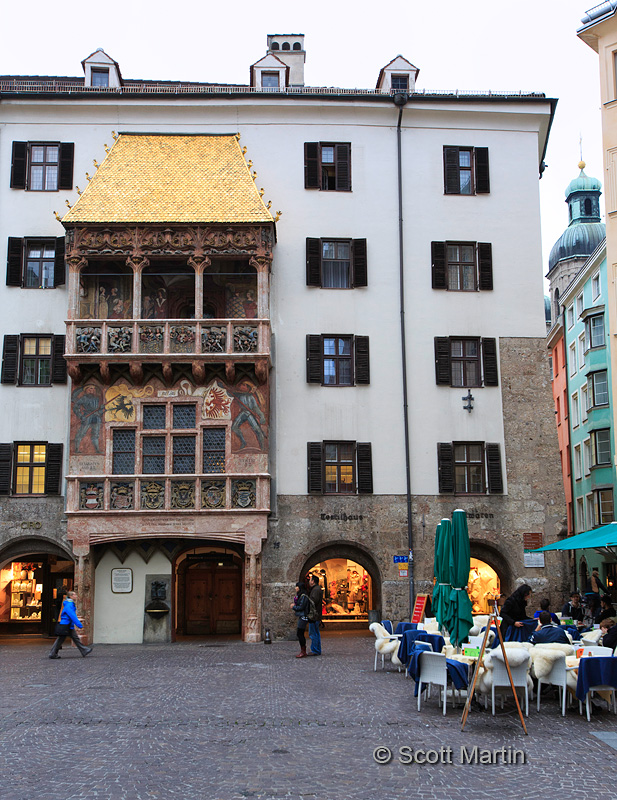
…and after dark.
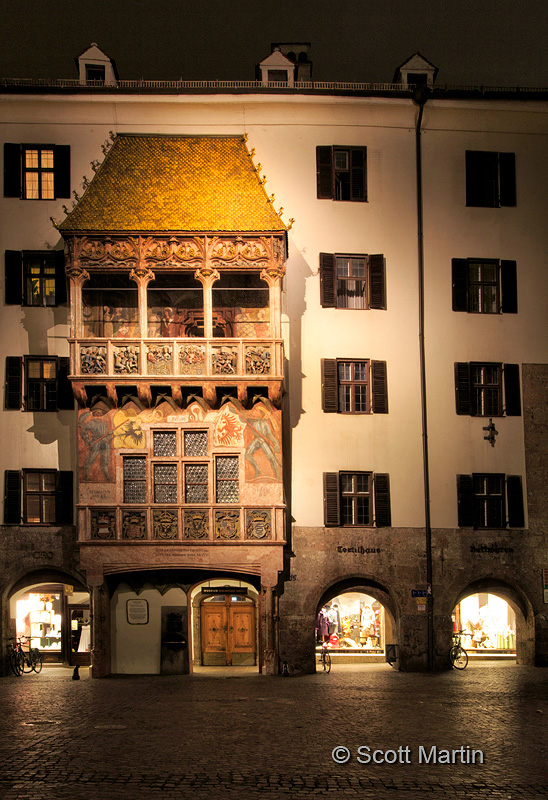
The town square in Old Town is a wonderful area that has remained relatively unchanged for the last 500 years. There are many cafe’s around the perimeter of the square that are designed for warmth in the colder weather, right down to the sheep skin throw blankets on every chair.
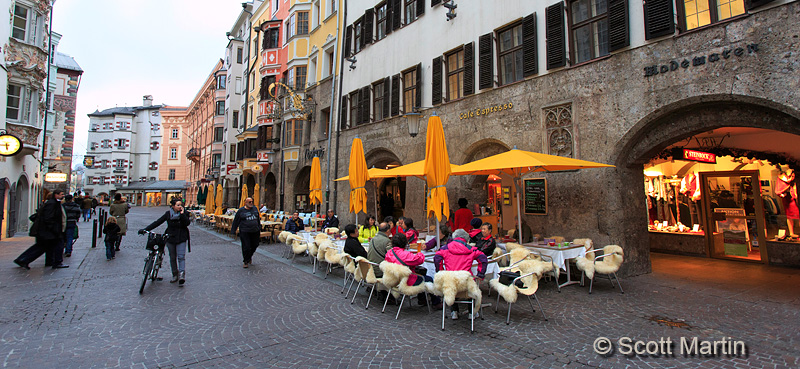
The Innsbruck Cathedral or Cathedral of St. James, a Baroque Cathedral built between 1717-1724.
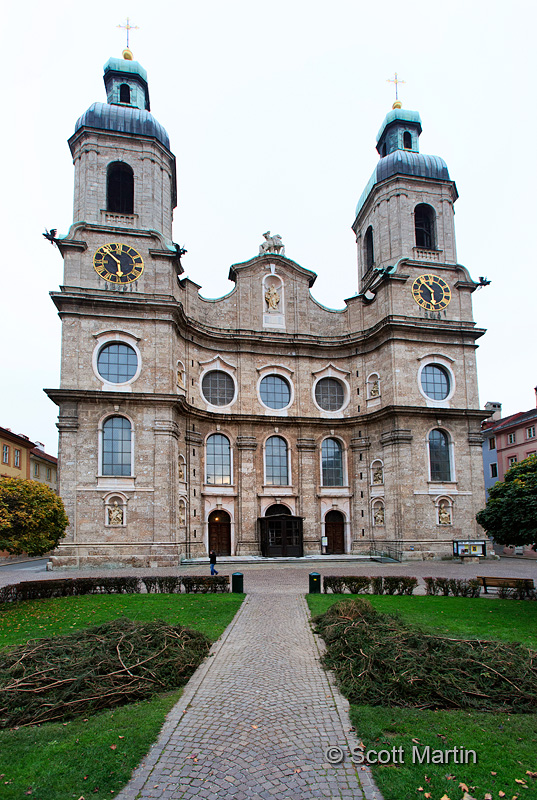
Helblinghaus dates back to the fifteenth century and was constructed as a town house. The ornate detail of the facade is in keeping with its neighbour with the golden roof!
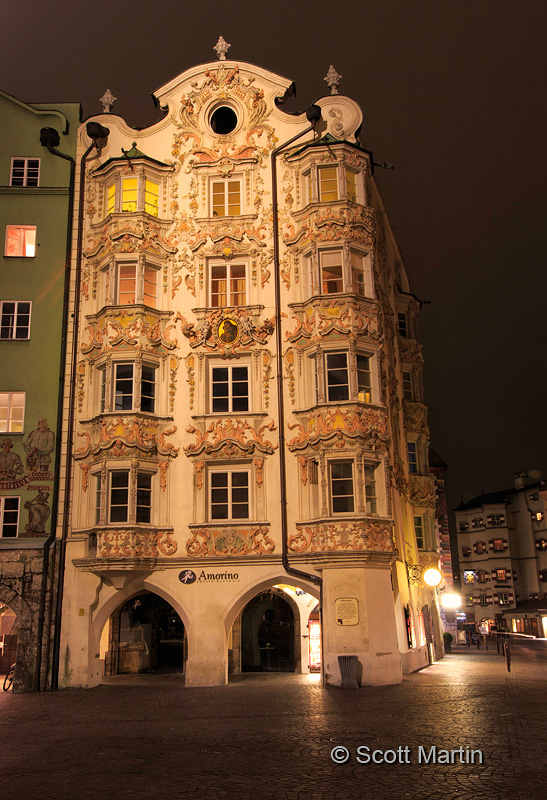
This last image from Innsbruck is the City Tower, another focal point of the Old Town district of Innsbruck.
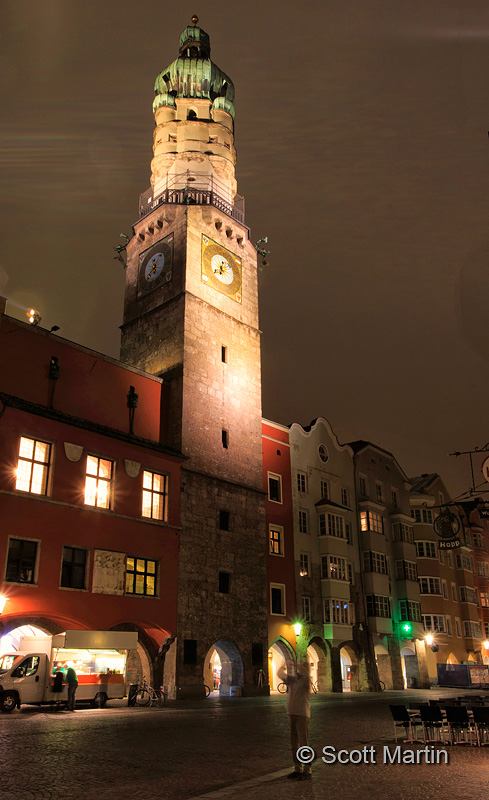
Following our very brief one night stay in Innsbruck we headed west, through Austria and Switzerland to our next stop which was Geneva, nestled on the edge of Lake Geneva on the Swiss/French border, some 580 km from Innsbruck. This day was designed for us to enjoy driving through the Alps and seeing one of the most picturesque mountain ranges in the world. We did enjoy the day however did not see a single mountain thanks to a very low cloud ceiling that day that extended the entire distance between Innsbruck and Geneva. Hopefully we will fare better the next time we make the trek!
Geneva is a fabulous city and it would have been nice to spend more time there, however we arrived late in the day and were on the road early the next morning heading towards Paris. The metropolitan Geneva area has a population of over one million people and has the third highest quality of life of any city in the world (after Vienna and Zürich). It boasts more international organization headquarters than any other city in the world and not surprisingly is rated as the third most expensive place in the world in which to live. We instinctively knew this because the burgers and fries at the restaurant where we had diner were thirty eight Euros!
For our evening in Geneva we headed down town to the old centre of Geneva where the University of Geneva is located. Adjacent to the university are some of the city’s cultural landmarks. Below is the Geneva Theatre.
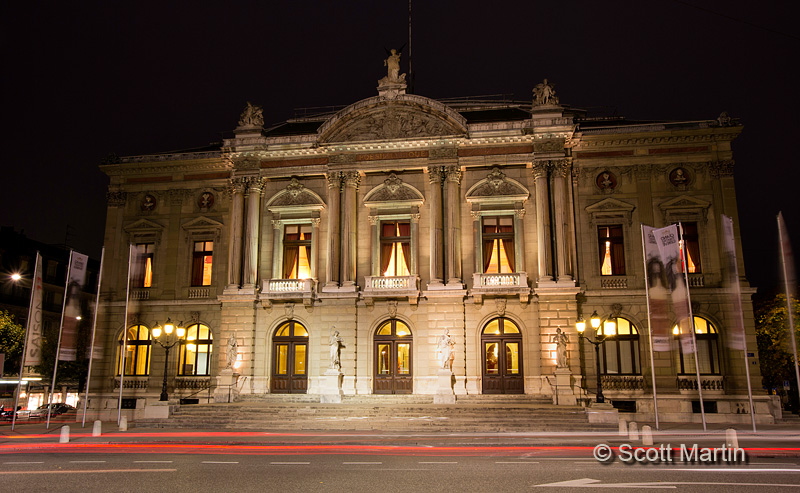
And a little different perspective. Unfortunately it was impossible to include the fountain and not the light standard.
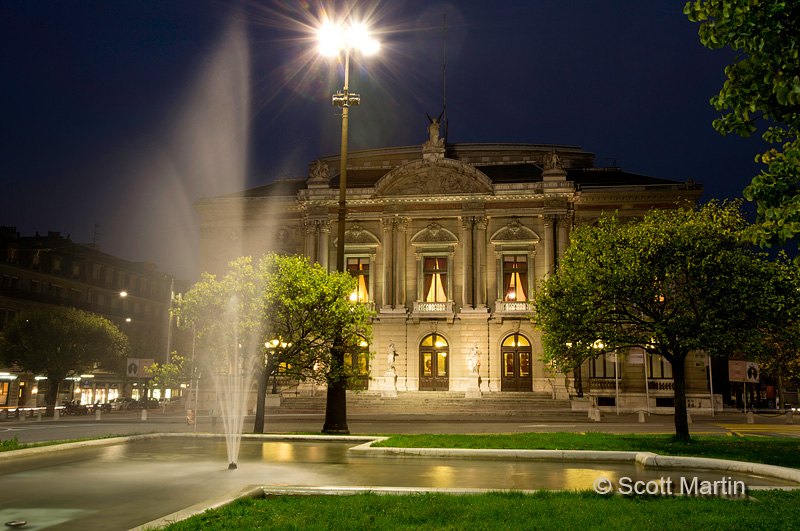
Next to the theatre was the museum , again with an annoying light standard. If you look closely you will note the streetlight is behind the statue of the horse & rider, which would typically result in the statue being underexposed as it was completely back lit. To solve this problem, during the thirty second exposure I grabbed the flash and ran up to the statue base and fired the flash at the horse & rider about six times while I made sure to never stop moving (so I didn’t show up in the picture). This technique is know as light painting and is a common practice in night photography. It takes a bit of practice but is not really that difficult….just don’t stop moving!
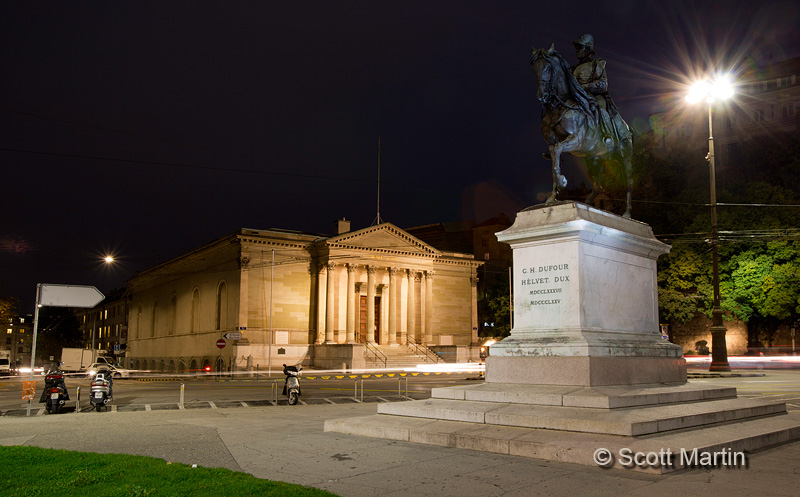
The University of Geneva is a sprawling campus in the heart of the old city. On its park like setting there are many academic buildings, lecture halls, dormitories and libraries however my favourite was this little cafe with bigger than life checker and chess boards out front for anyone to play.
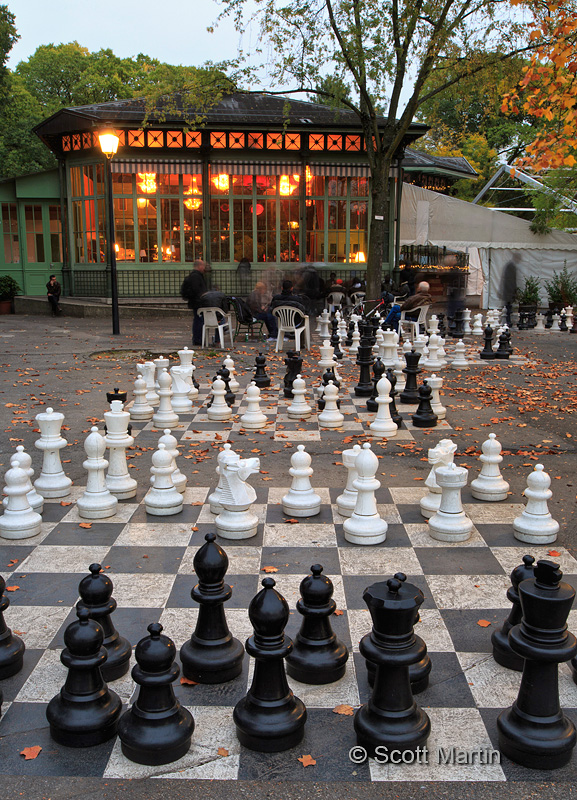
The reason we visited the university was to see Reformation Wall which is a 100 metre long monument built into the side of the old wall of the city of Geneva. Reformers Wall was constructed in 1909 to commemorate the 350th anniversary of the founding of the University of Geneva by John Calvin on June 5, 1559. The wall features ten prominent theologians of the Reformation period in the mid fourteenth century. Although John Calvin is noted as the founder of the university, he is best know for his role in the Protestant Reformation initiated by Martin Luther who nailed his Ninety Five Theses on the door of his church on October 31, 1517, a document that ‘protested’ (hense Protestant) the theology, doctrine and structure of the Roman Catholic Church. In 1536 John Calvin published his opus “Institutes of the Christian Religion”.
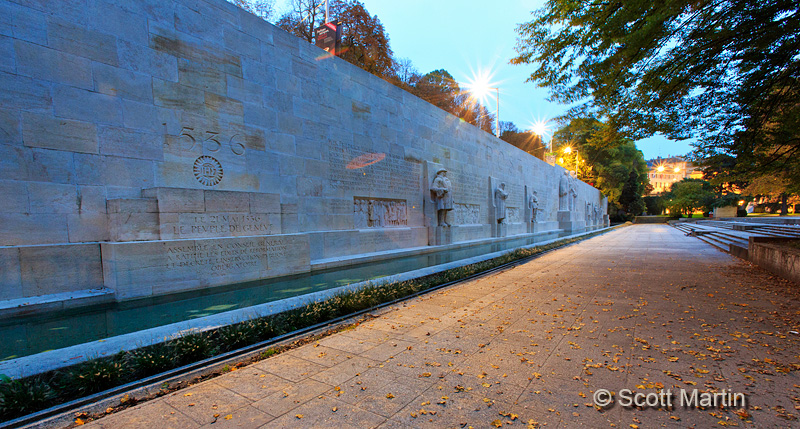
In the centre of Reformation Wall are statues of (from left to right) William Farel, John Calvin, Theodore Beza and John Knox that stand 16.5′ high.
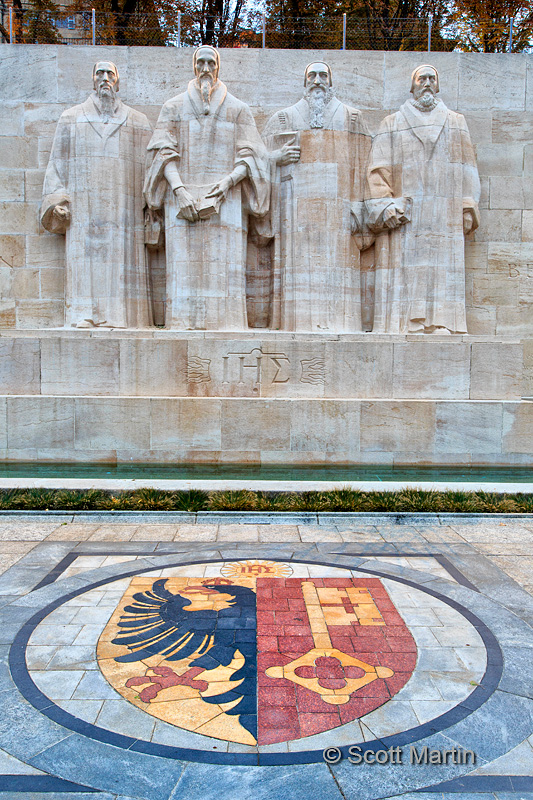
Although the above image may look like it was taken on a dull day, it was really taken in the virtual dark and is a 25 second time exposure.
I trust you have enjoyed these few images from Innsbruck and Geneva. It was unfortunate that we couldn’t spend more time exploring these two cities but it is impossible to fit everything into one trip! After one night in Geneva we headed to Paris where we spent almost three days and took enough photographs to supply the material for more than one blog post.
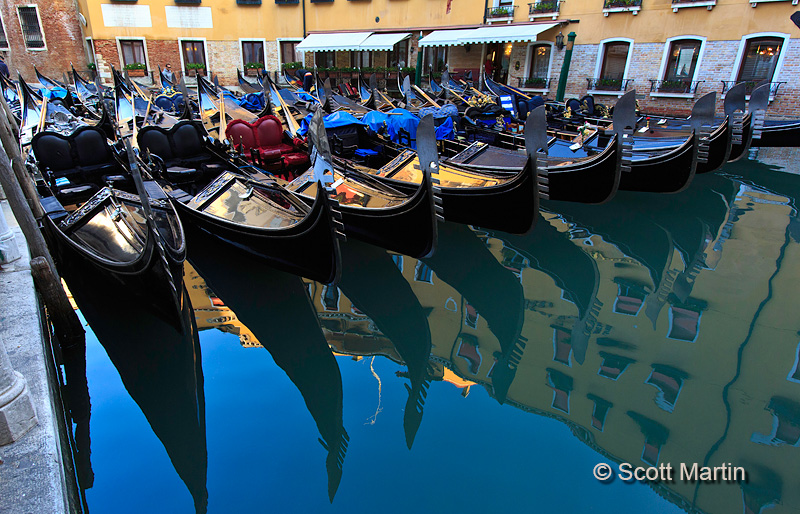
by Scott Martin Photography | Nov 16, 2013 | Blog, Cityscapes, Landscapes, Travel
This last blog post from Venice will highlight some of the more artistic, iconic views of the city that I trust will show the wide-ranging photo opportunities that exist in The City of Light. Venice has many nick names and the one I’ve chosen today serves to highlight the fact that lighting is the most important factor that must be considered when talking any picture. Being at the right place with bad light means you are there at the wrong time. Deb and I spent our first half day in Venice with a professional photographer, Marco Secchi, and our time with him was invaluable. Marco showed us the sights of Venice, had us at the right places at the right time when the light was perfect and helped us plan the rest of our time in Venice allowing us to find the best places to fully experience the city in the almost three days we spent there. Most of the images in today’s post were taken while we were with Marco. If you ever plan to be in Venice, you need to arrange your travel plans around Marco’s schedule!
Some of the 450 gondolas that ply the canals.

These next two images illustrate how two very similar pictures can create different results based on a slight change in composition. I probably took a dozen or more shots of this scene, and am still not sure which of these two is the best result. Always take time when you find an interesting scene to explore many different angles and compositions in order to arrive at the best result.
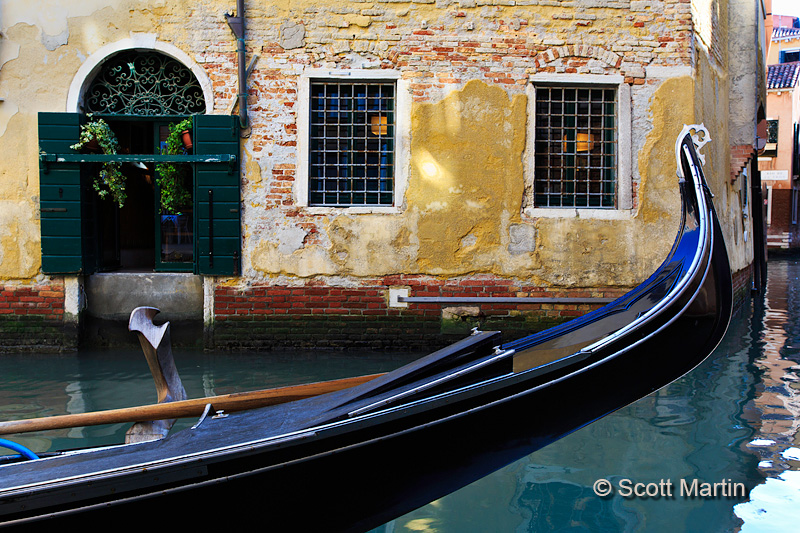
.
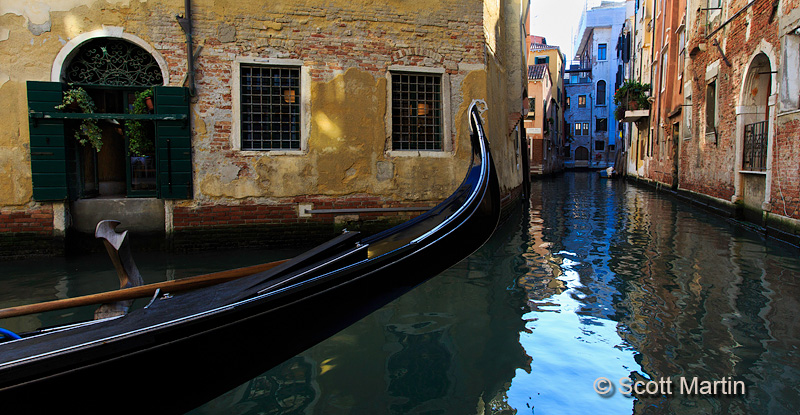
Sometimes when the sun is in the absolutely the wrong place for a photography, you can be creative and make it work in your favour. Thanks to Marco for teaching me to think ‘outside of the box’ and take a shot like this one.
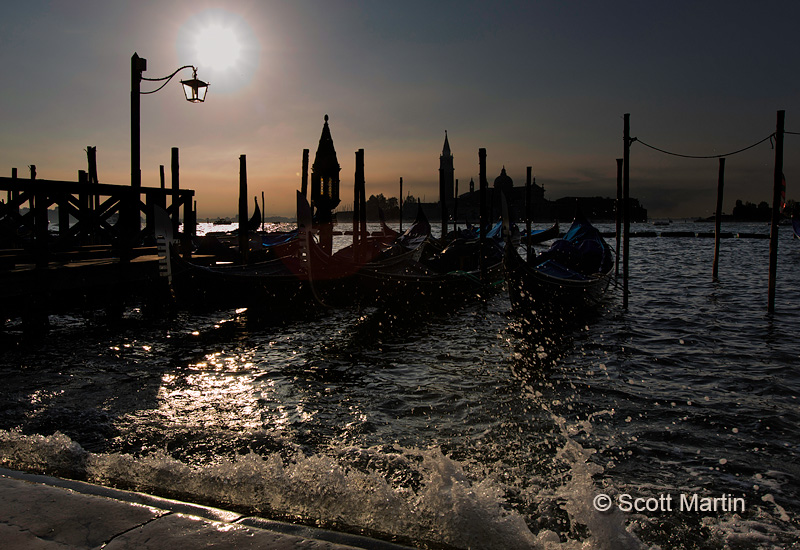
The Bridge of Sighs taken using the old white marble rails of the bridge as a frame.
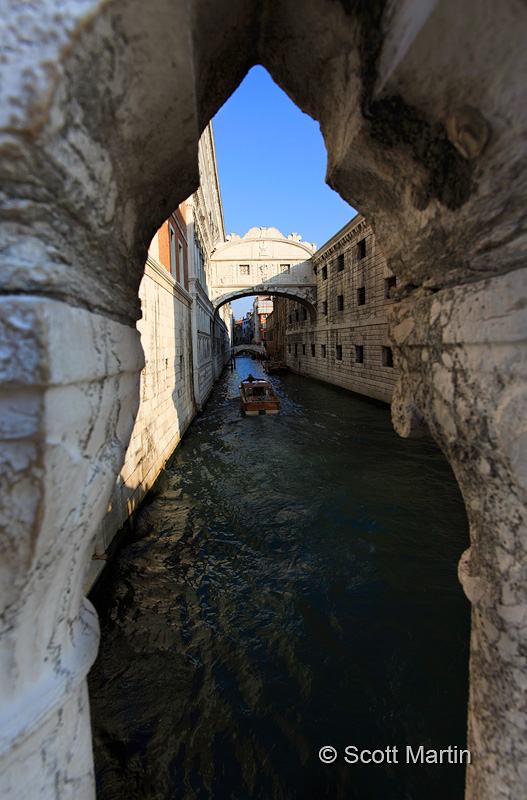
And a more traditional view.
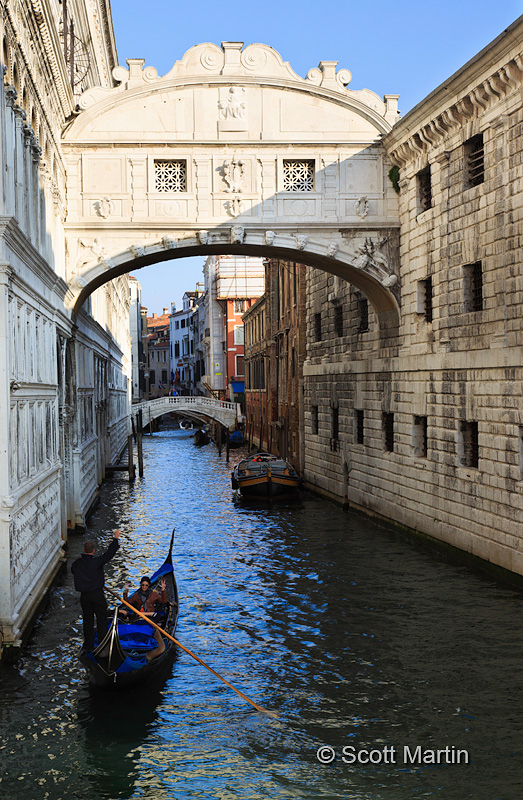
The ornate veranda columns of Doge’s Palace and the interesting shadows they cast.
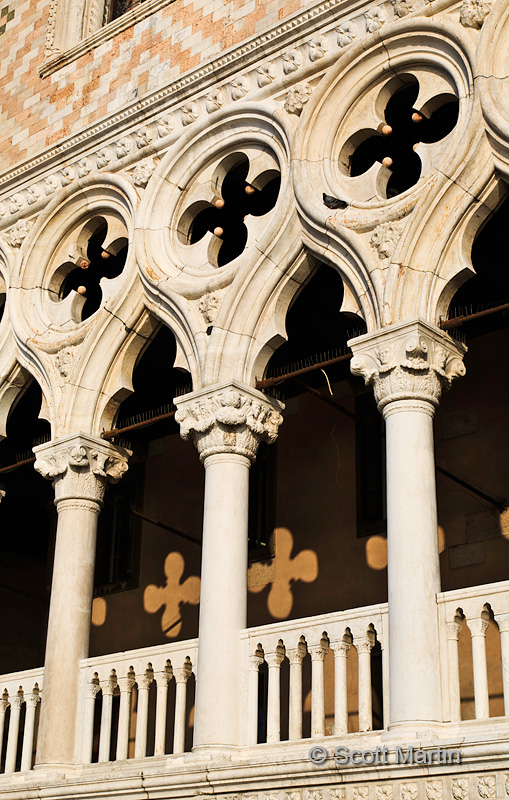
A charming Venetian Street.
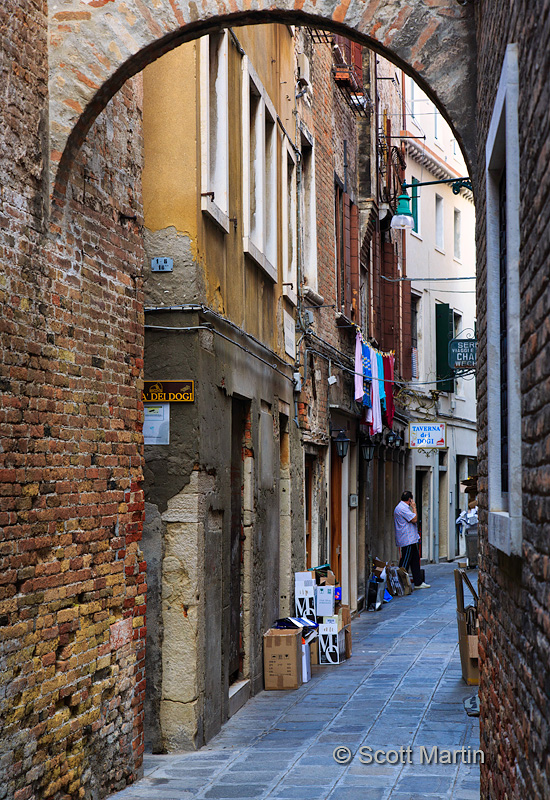
The next two shots are of the crypt below San Zaccaria, a church named after Zacharias, the father of John the Baptist. Zacharius’ body is on view in the church. The crypt below the church was flooded, however by climbing down a few old wooden stairs it was possible to get some pics. Unfortunately I did not have a tripod with me at the time so these shots are taken hand-held, ISO 4000 f/4 at 1/4 of a second.
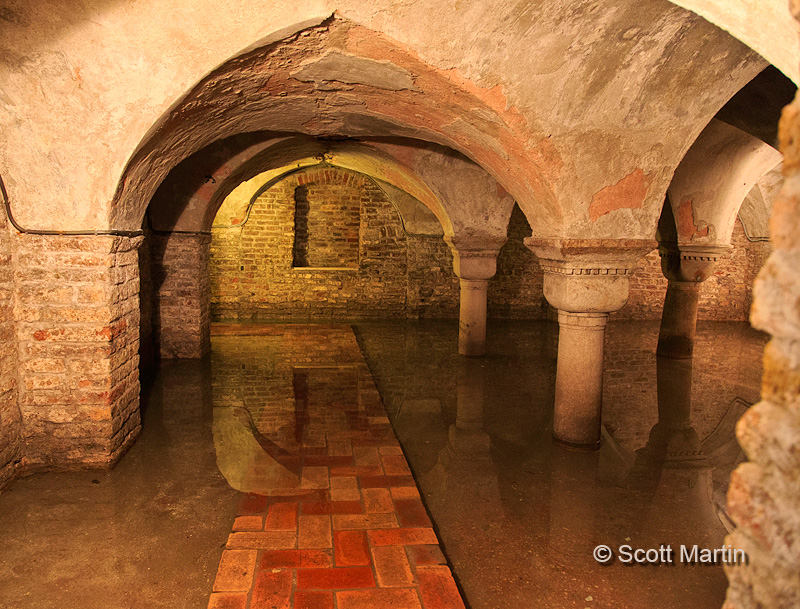
.
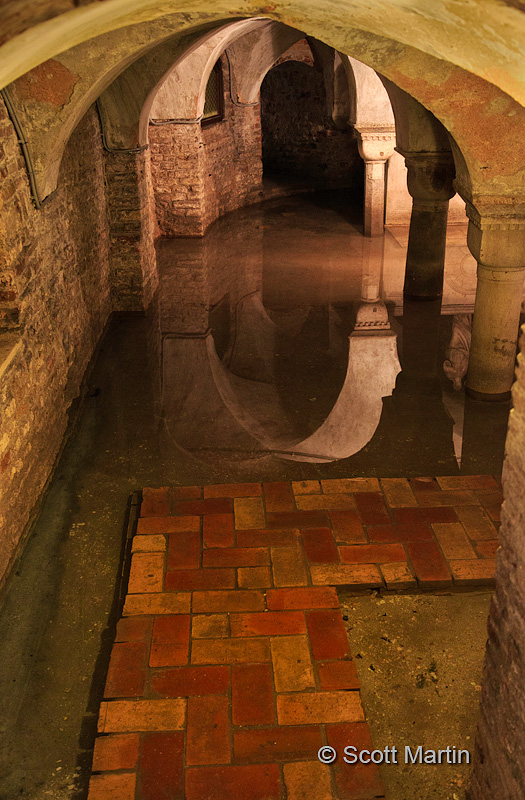
A gondolier navigating the narrow canals. No three point turns here!
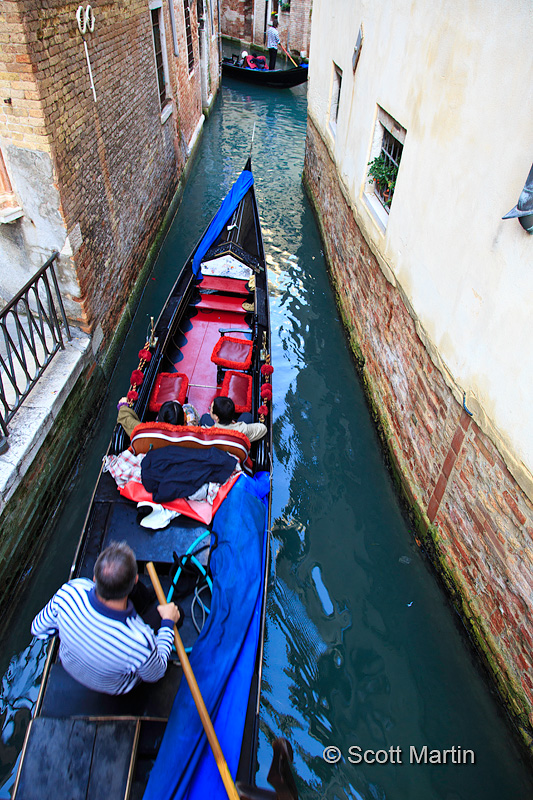
You could spend days simply photographing the windows and doors of Venice. This next image demonstrates how over the centuries nothing remains square in the city that is slowly sinking into the lagoon on which it is built.
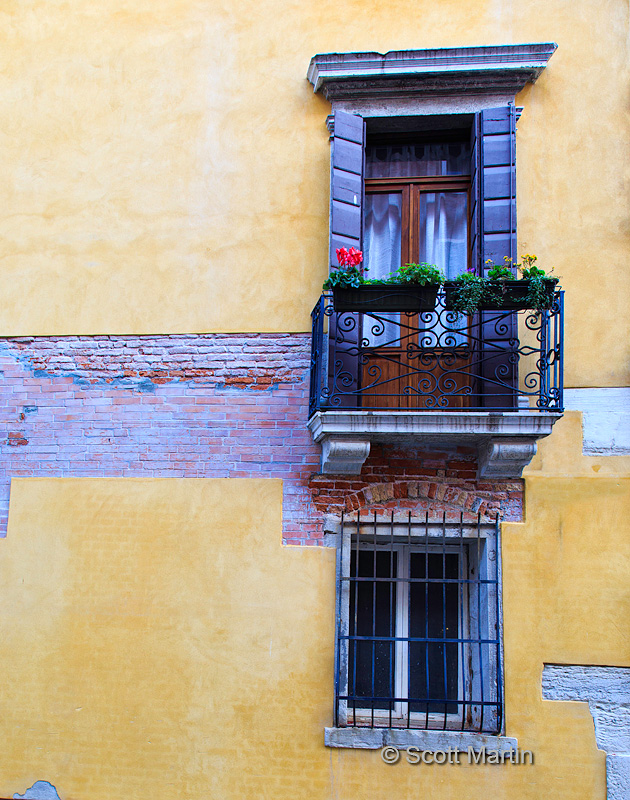
This next shot has all the quintessential components that make it easily recognizable as being from Venice.
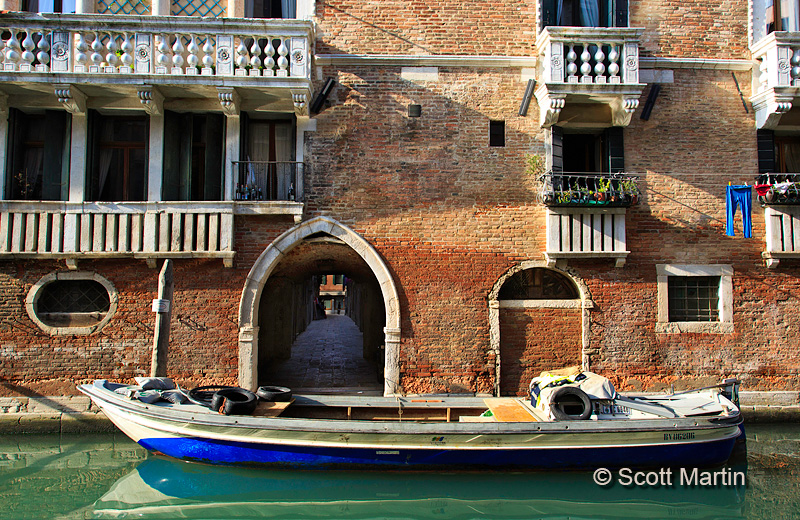
It’s great for a photographer when the colour of the clothes on the line match the boat 🙂
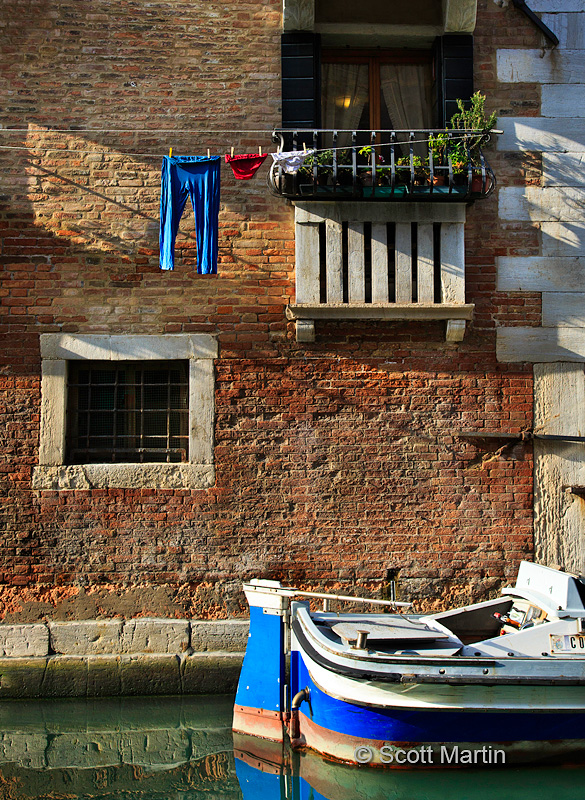
.
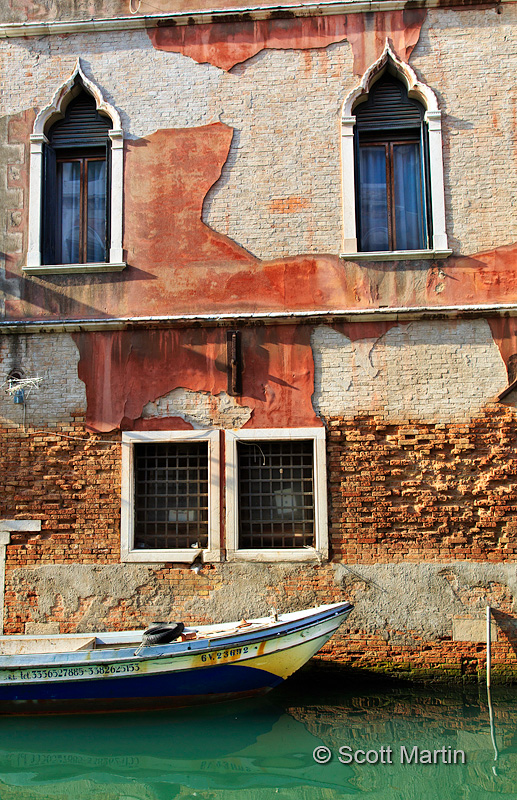
The long history and rich tradition of the gondolier is evident in the ornate detail of their gondolas.
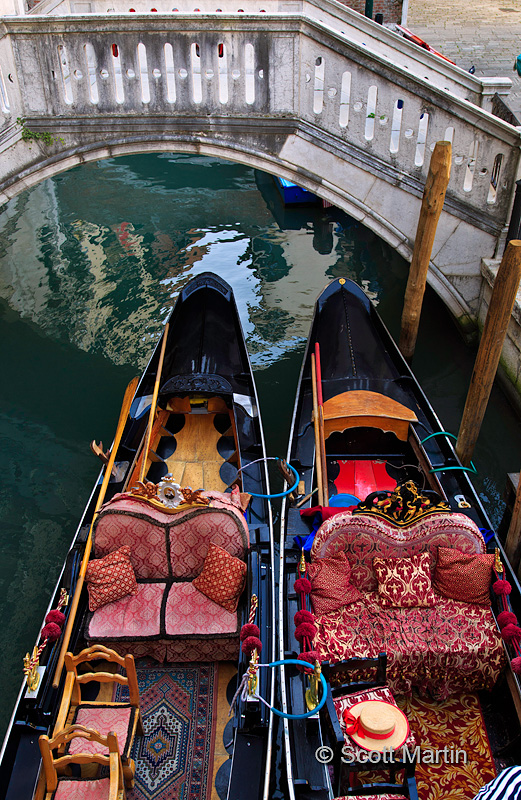
.
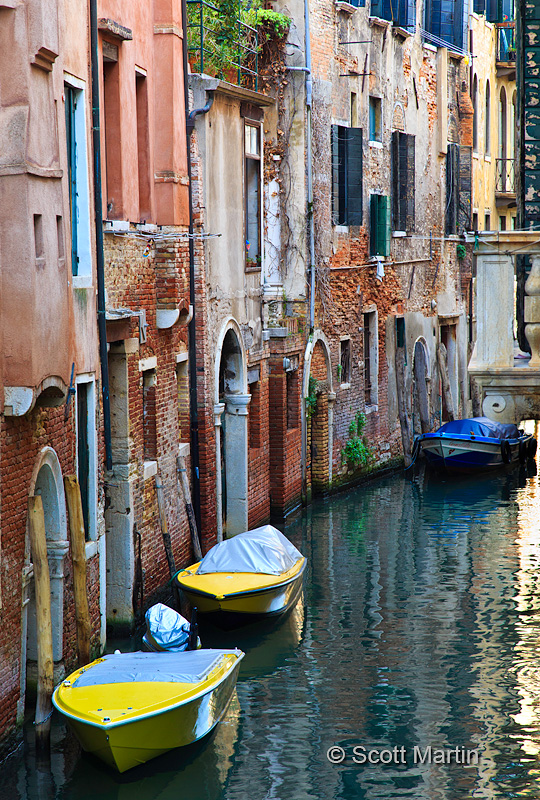
The Acqua Alta Bookshop was the most interesting and unique bookshop we have ever been in. You have to see it to believe it and we were so happy that Marco took us by for a visit.
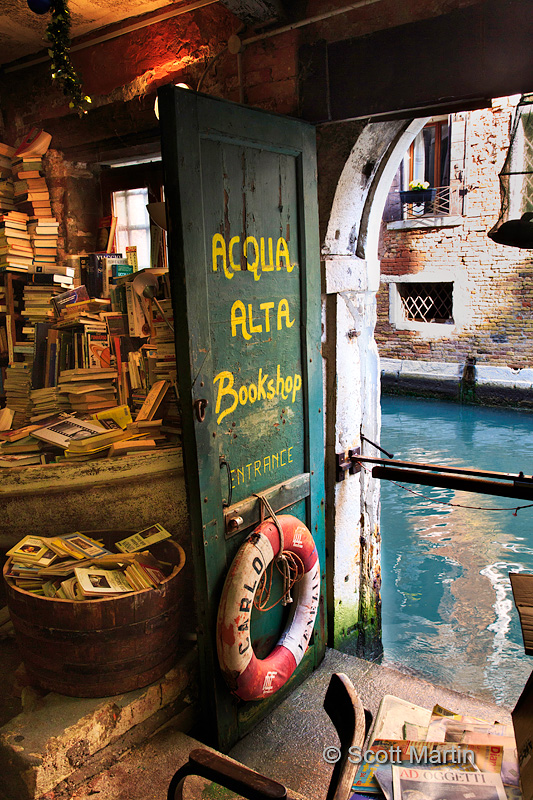
Unfortunately graffiti is a problem in Venice (as in most cities) so I’ve purposely included in this next shot of a well.
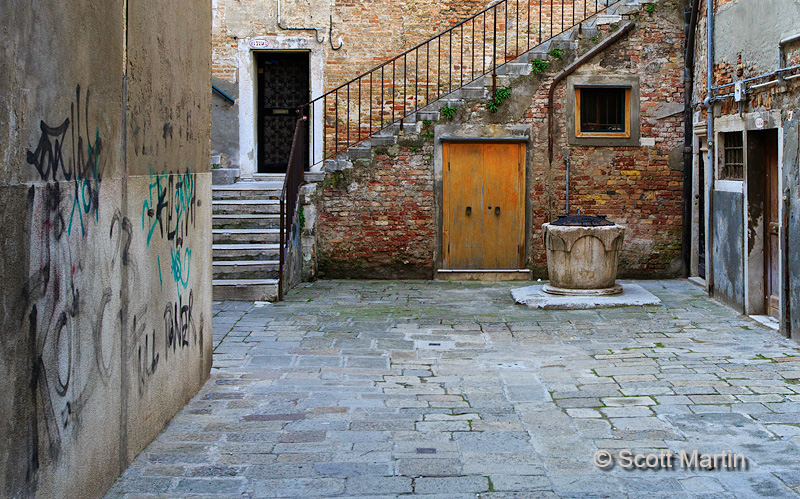
Here is an image of the same well composed to exclude the graffiti and create a completely different result.
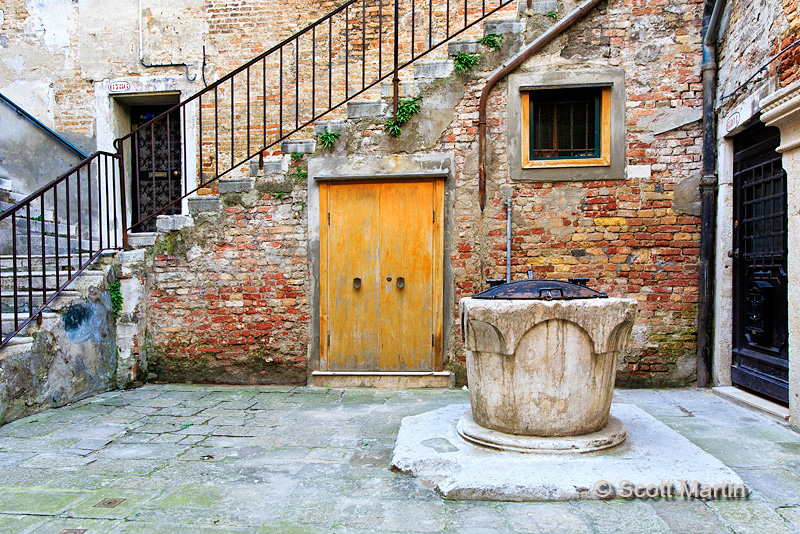
And for something totally different, a close up of red and green peppers at the market.
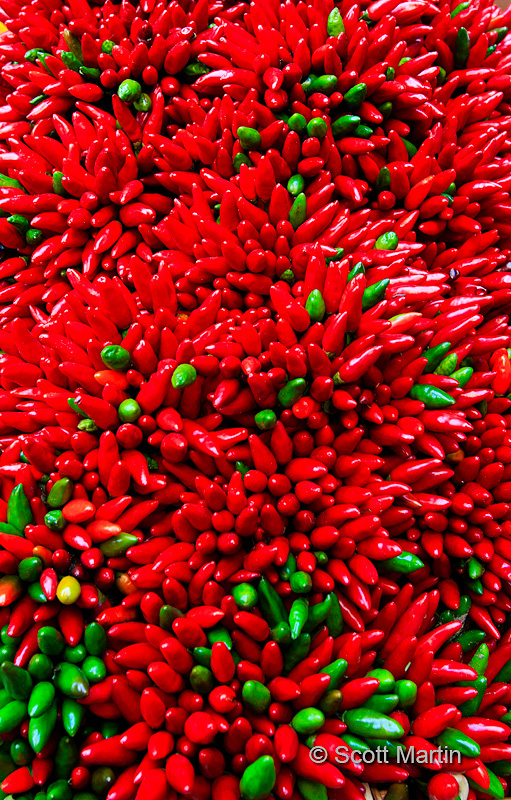
Every archway leads to a wonderful view.
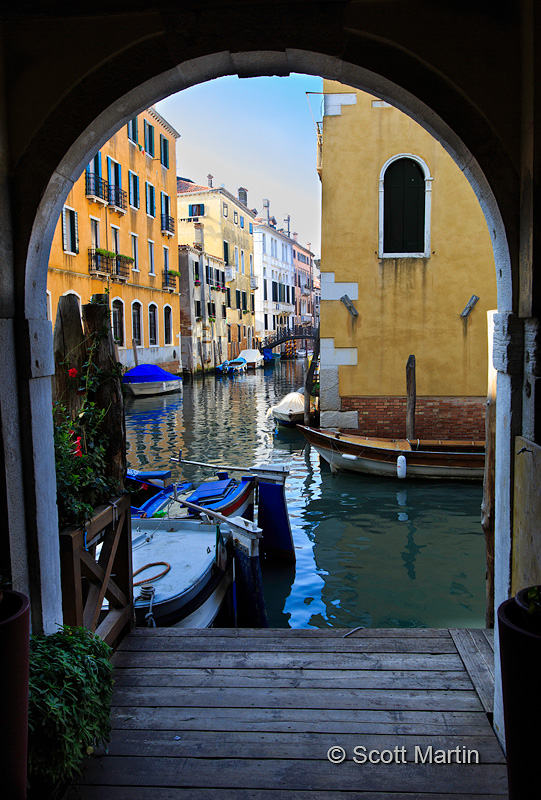
Although you’ve seen this final image before, it represents the sun going down on our time in Venice. I trust you’ve enjoyed this three part series from Venice and these photographs have either brought back fond memories of a past visit or perhaps persuaded you to add this beautiful city to your list of places to visit.
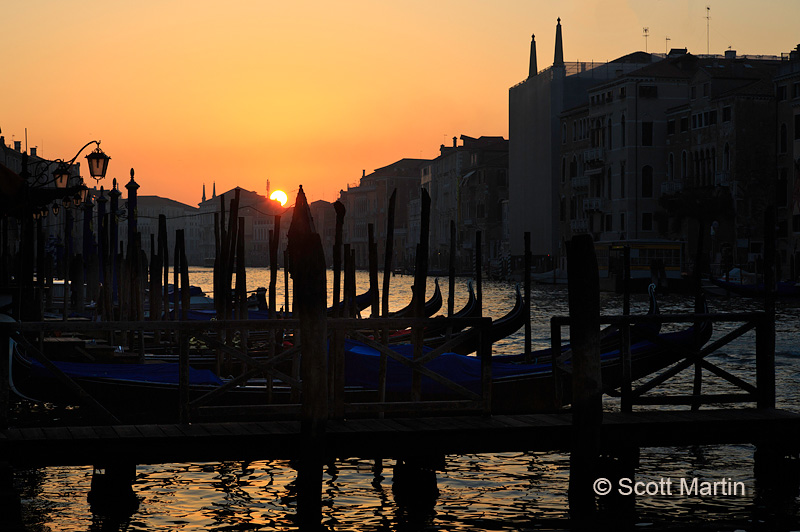
All of the images from Venice can be seen in the Venice Gallery
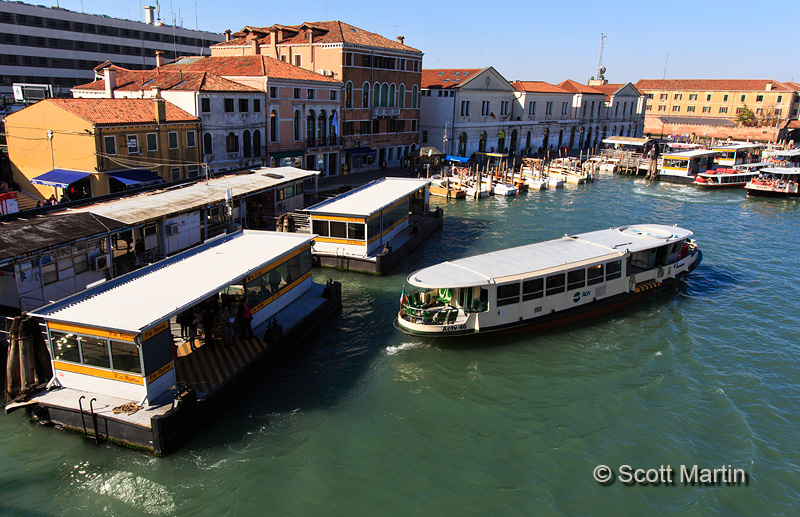
by Scott Martin Photography | Nov 9, 2013 | Blog, Cityscapes, Landscapes, Travel
Venice is an incredible city that is one of those “bucket list” places to visit. The Floating City as it is often referred to was formed around the sixth century as the Roman Empire’s power base was diminishing and attacks from the Lombards and Huns caused the people to form the defensive stronghold that became Venice, protected from easy attack by the lagoon that separated it from the mainland. The first Doge of Venice (most senior elected magistrate, elected for life) was elected around 700 AD and a continuous rule of Doge’s lasted for the next 1,000 years.
The entire city of Venice is a World Heritage Site and although in 1500 it was one of the most populous cities in the world by the end of WWII the population was 175,000 and in 2010 the population dipped below 60,000 which is less than the average number of tourists who visit the island city every day. The declining population is likely due to the very high cost of living, ironically created by the volume of tourists, causing many native Venetians to relocate to the mainland.
Arriving in Venice by car, you cross via a bridge/causeway, continue past the docks where the cruise ships rest and arrive at a multi-level parking garage where you gladly leave your car, grab your luggage, and head for the entrance of the Grand Canal where any manner of water transportation awaits. We chose the Vaporetto, which can be thought of as a water bus. This pic below shows the first Vaporetto stop at the mouth of the Grand Canal with the parking garage in the back ground.

The image above was taken from the apex of the Calatrava Bridge, which is pictured below. This bridge is one of only four that span the Grand Canal and was completed in 2008 making it the newest bridge in Venice. The Calatrava Bridge is a bit controversial in that it is a stylistically modern design, constructed of steel and glass seems esthetically disconnected from rest of the city, however it is the last ‘modern’ sight you will see until returning to your car.
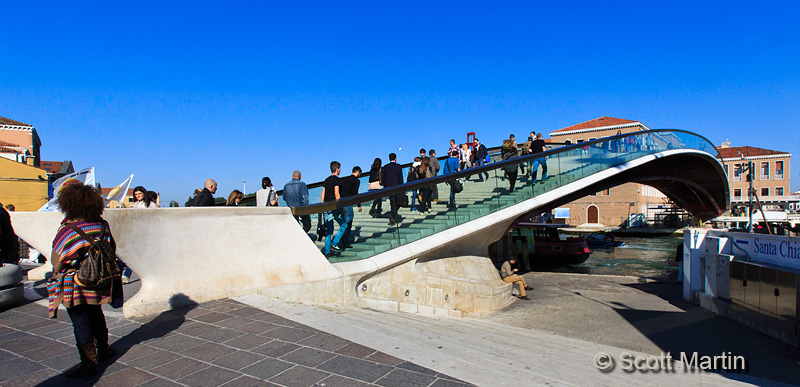
Calatrava Bridge
From the same vantage point atop the bridge but looking down the canal you get your first feel of Venice.
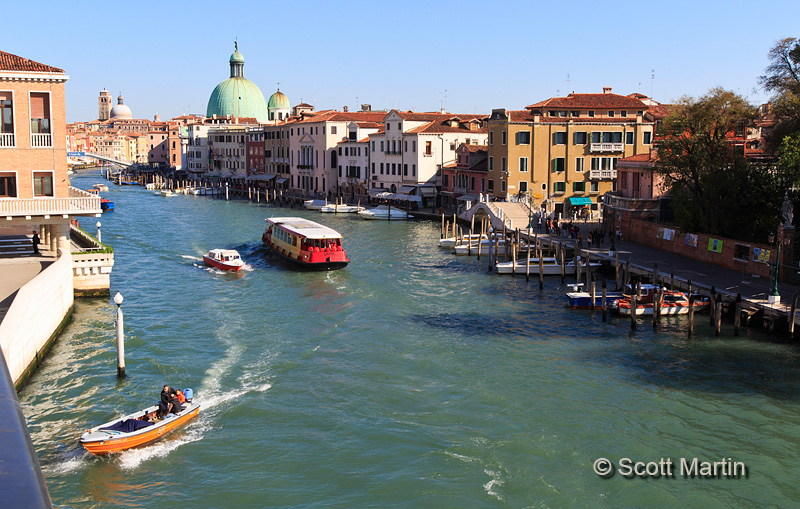
.
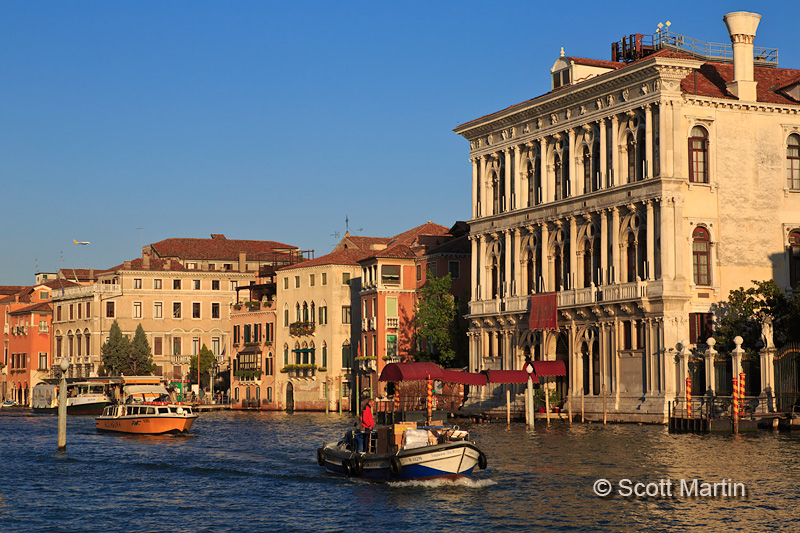
.
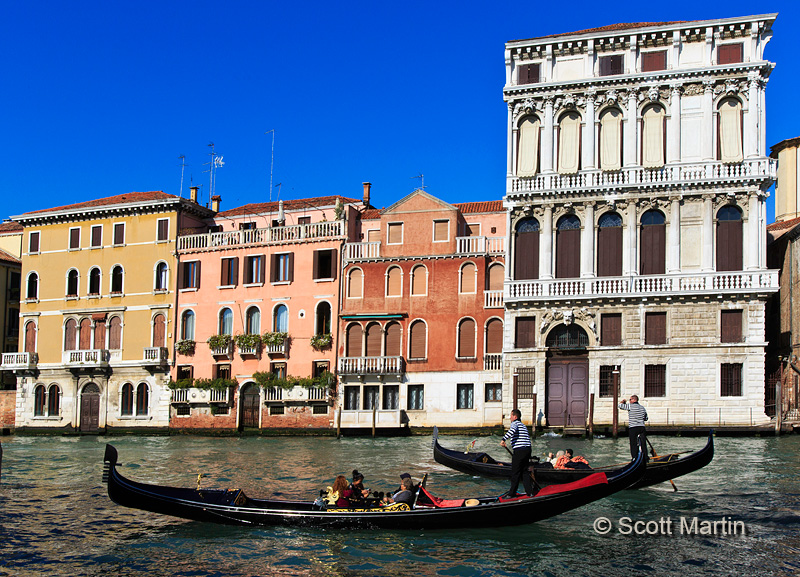
Although the Calatrava Bridge is the youngest and most controversial of the four bridges that span the Grand Canal, the Rialto Bridge is the oldest,most famous and most photographed of the quartet. The first iteration of what is now the Rialto Bridge was a pontoon bridge constructed in 1181 and replaced with a timber structure in 1255. The present stone version was completed in 1591. The Rialto Bridge and the gondolas that ply the waters beneath it are two of the most iconic fixtures of Venice. Trying to include both effectively in the same frame was a bit of a challenge but I hope we succeeded.
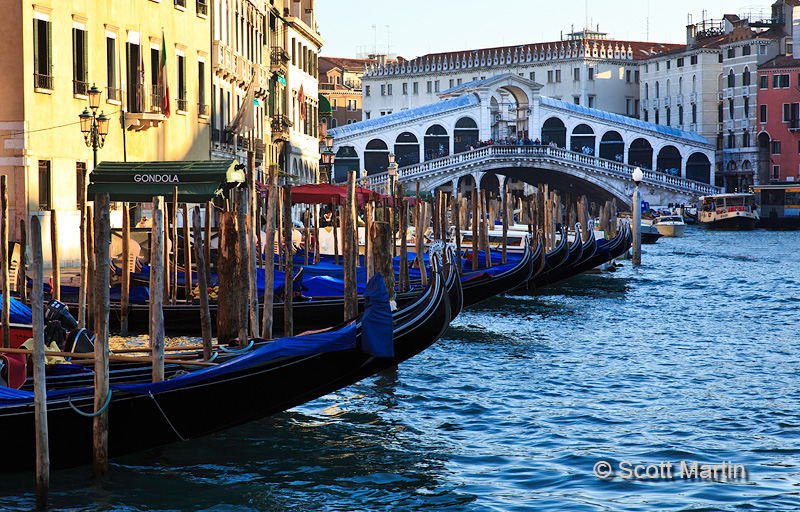
.
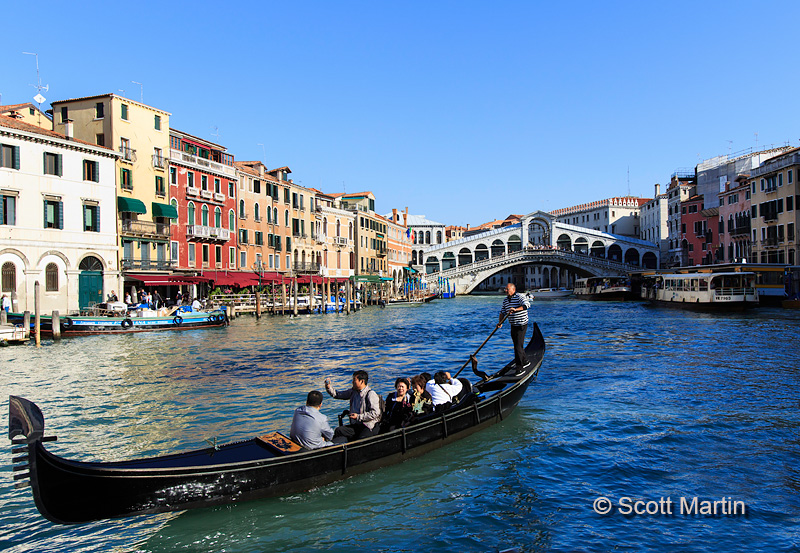
There are about 450 Gondoliers in Venice and based on tradition, you are born a gondolier in that a gondolier’s training and licence is passed from generation to generation, typically from father to son, however the first female gondolier in over 900 years was licensed in 2010. To be a gondolier in Venice makes one part of a proud and revered profession which I believe is captured in this next image.
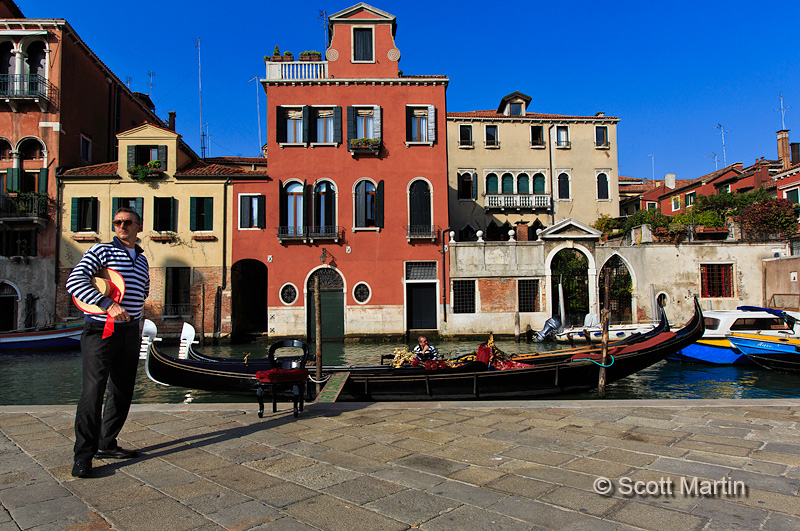
There are many quaint boutique type hotels in Venice and staying in the city adds to the charm of visiting Venice. A good example of this type of hotel is the one we stayed in, which began life as a fifteenth century palace and I would highly recommend. In fact, click here to visit their website.
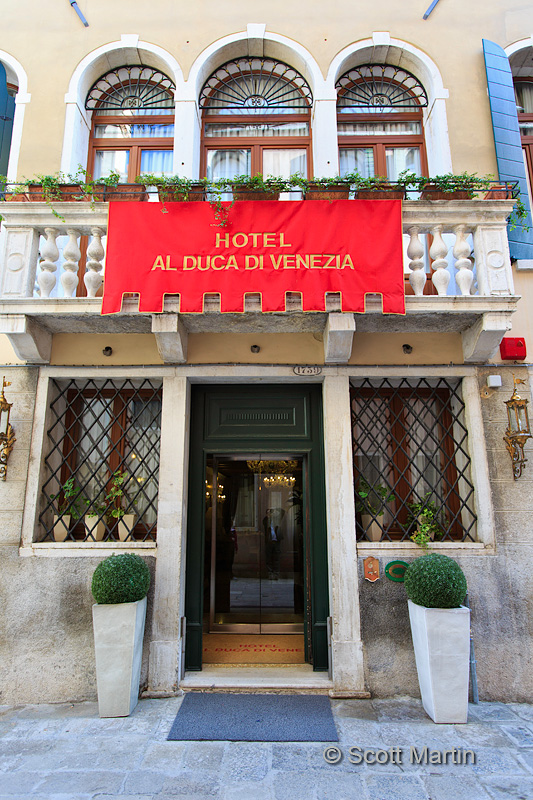
There are also hotels on a much grander scale. This angelic marble statue marks the stairway leading to the upper floor drawing room of one of Venice’s more spectacular hotels.
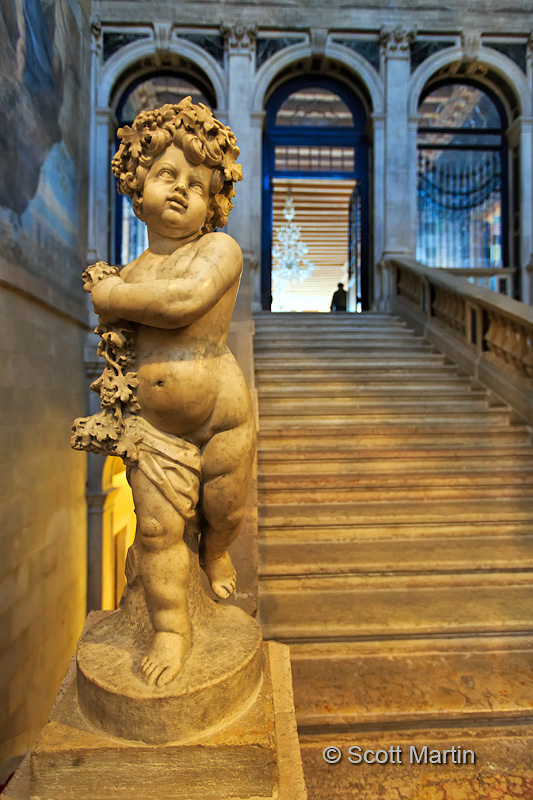
.
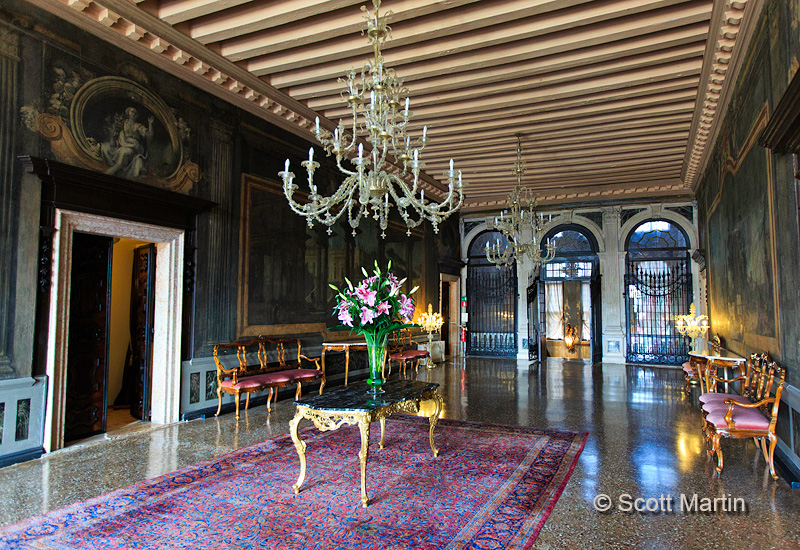
Perhaps the best known landmark of Venice is the Piazza San Marco, or as Napoleon referred to it, the drawing room of Europe. The vast expanse of the piazza can easily accomodate tens of thousands of people and it is certainly the social centre of the city.
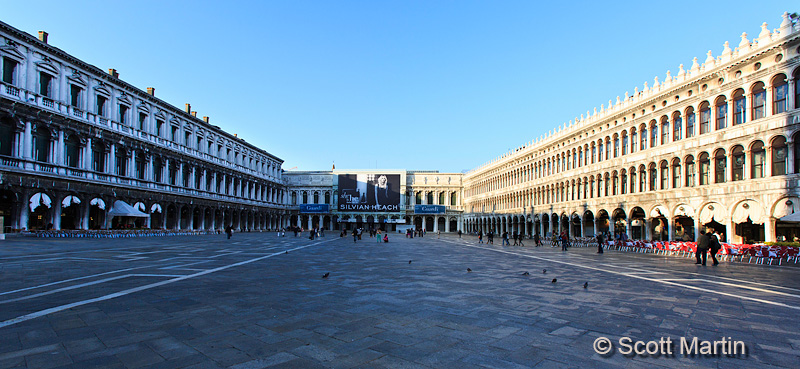
St. Mark’s Basilica dominates the east end of the Piazza San Marco while its campanile (a stand alone bell tower associated with a church) rises proudly from the piazza.
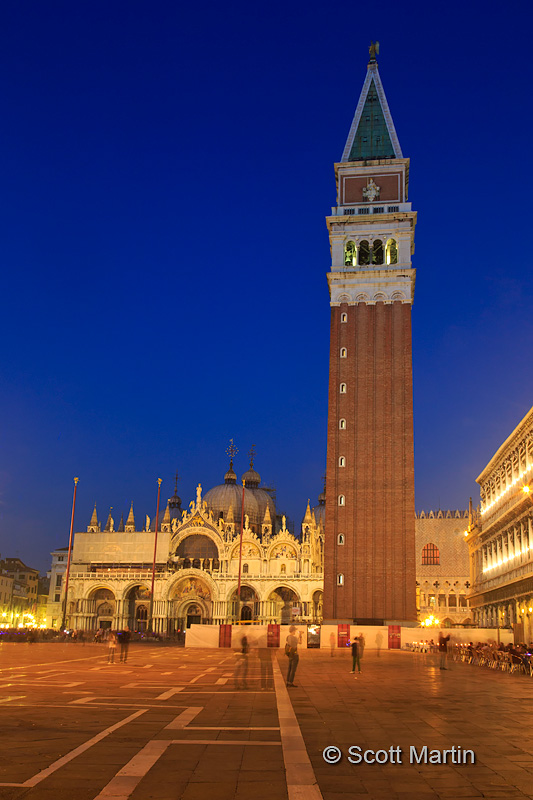
At the south east end of the piazza is another smaller area known as the Piazzetta di San Marco which runs between the Piazza and the lagoon and is bounded by the Marciana Library and Archaeological Museum on one side and Doge’s Palace on the other.
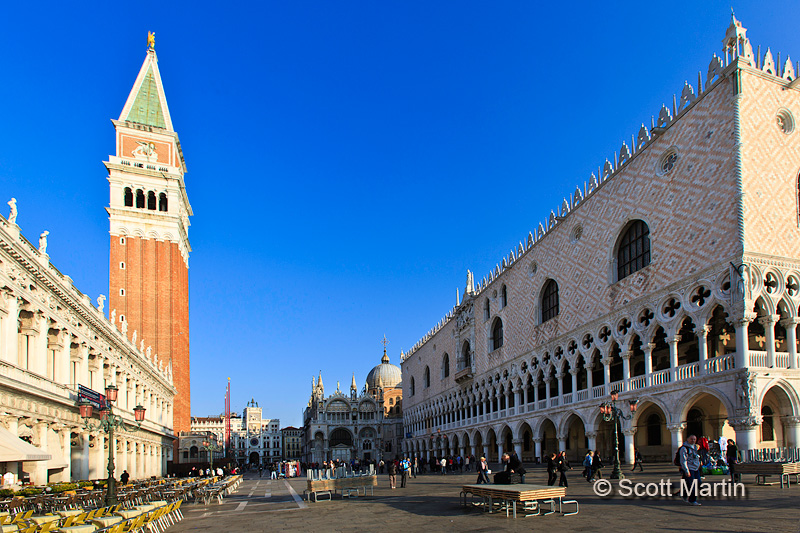
The objects that look like picnic tables in the fore ground are actually stacked portable walkways that are found throughout the public walkways of Venice. When needed they are separated and lined up end to end allowing pedestrians to stay dry and walk around the city when it is flooded which happens approximately one hundred days annually.
The Library, Archaeological Museum and Column of St. Theodore, one of the two patron saints of Venice.
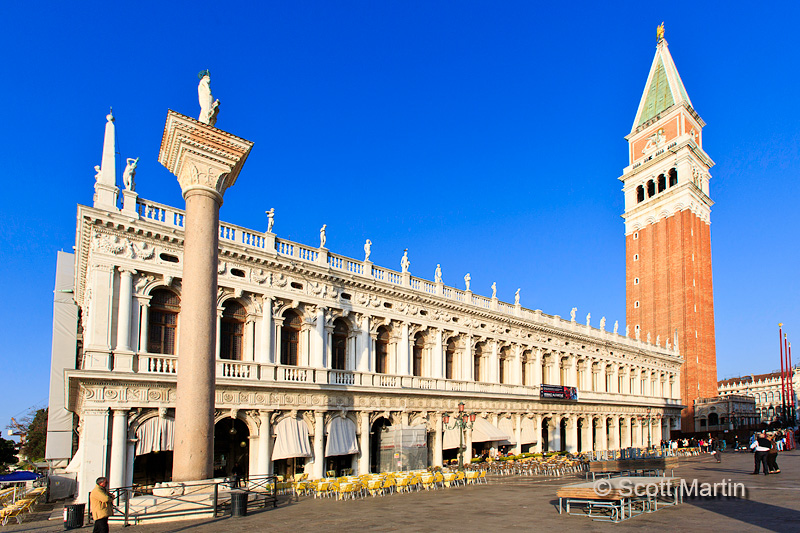
The Piazzetta taken from the lagoon with Doge’s Palace on the right side of the frame.
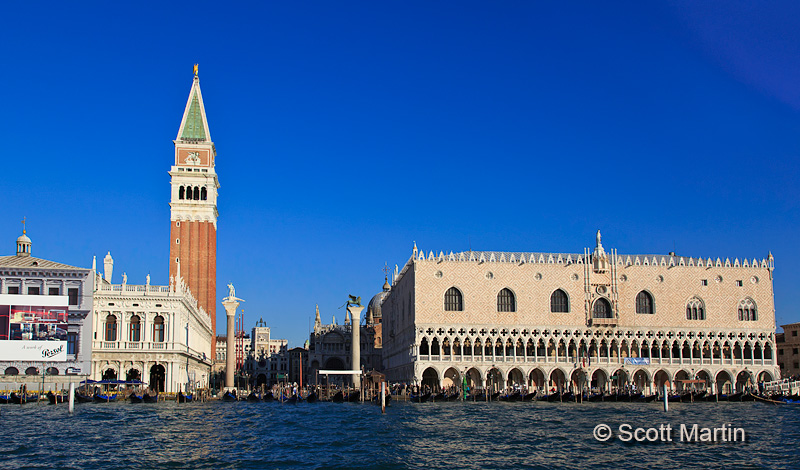
Next to Doge’s Palace, separated by a canal, is the New Prison. The famous Bridge of Sighs was built in 1614 to connect the two buildings. The bridge is completely enclosed with only small grated openings that allowed prisoners, freshly convicted by the magistrates in the palace, to catch their last view of freedom looking out through the grates to see the lagoon and the island of San Giorgio Maggiore as they were being led to the prison. The sighs they would utter gave the bridge its name.

In this next twilight image it is interesting to note the stark differences in architectural style of the palace on the left and the prison on the right.
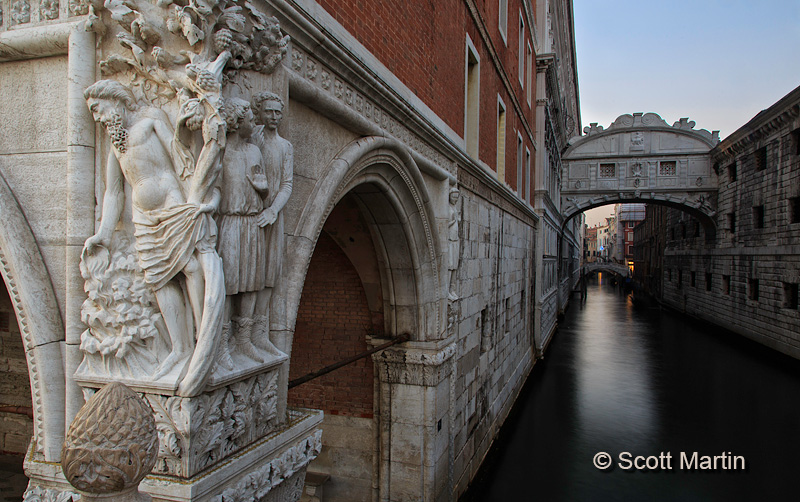
Venetians typically do not have freezers in their homes and rely on fresh food daily which is probably a good idea that we should all emulate. Markets are found throughout Venice and greatly add to the charm of the city.
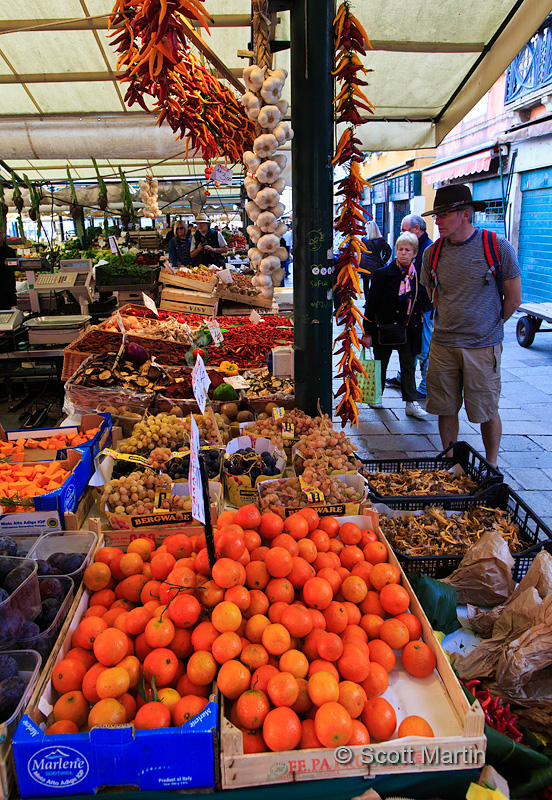
I trust you have enjoyed this more travelogue type view of Venice and that it has given you a good sense of feel for this wonderful city. The next blog post will be a more artistic photographic tour of Venice.
To close this post, we head over to the island of San Giorgio Maggiore and to the top of the bell tower of the Church of San Giorgio Maggiore which provides the perfect vantage point for a view of Venice. While at the top of the bell tower my 24-105mm lens suffered a catastrophic failure and and this was the last time I used the lens on our vacation. I’m sure the photographers reading this will feel a little sorry about my misfortune 🙂

.
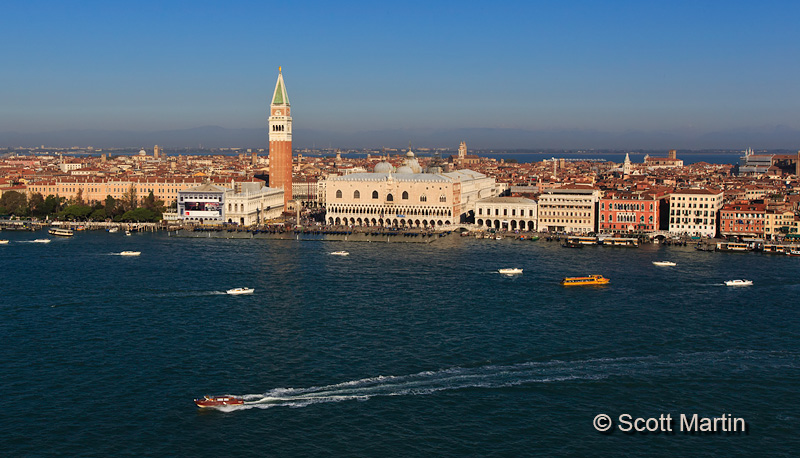




























































Follow Scott Martin Photography